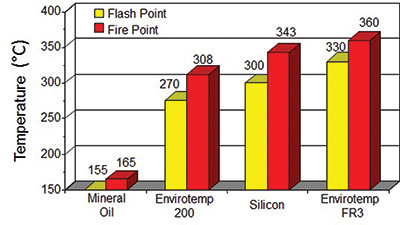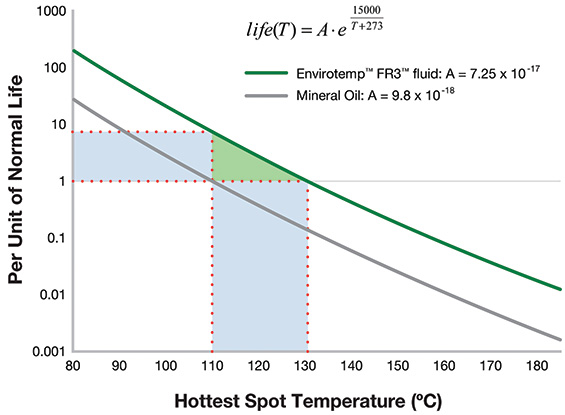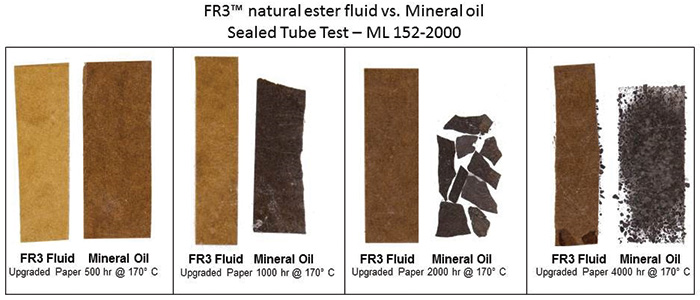Once viewed as a nice, niche product for applications where environmental safety was at a premium, a recent trend reveals more and more power companies turning to natural ester fluids as a transformer coolant and insulator that delivers the operating efficiencies they need to stay competitive.
India’s largest integrated power company, Tata Power, announced in June that it will use a natural ester fluid in all of its new packaged substations across its Mumbai distribution area. Tata Power serves more than half a million residential and industrial customers. Together with its subsidiaries and jointly controlled entities, Tata operates an installed gross generation capacity of approximately 8,560 MW.
Earlier this year, Transnet BW – a transmission network operator in the German state of Baden-Württemberg – commissioned a 420 kV power transformer in one of its substations in southwest Germany that is cooled and insulated with vegetable-oil-based, natural ester fluid. The substation, which has a power rating of 300 MVA with an overload condition of up to 400 MVA, is the first in this high-voltage category to be filled with natural ester fluid.
CPFL Energia, Brazil’s largest privately owned energy company, announced in 2013 that it would begin transitioning its entire distribution network to natural-ester-fluid-filled transformers. CPFL serves some seven million customers in 569 towns and cities across southern Brazil. Like Tata and TransnetBW CPFL selected Cargill Industrial Specialties’ Envirotemp™ FR3™ fluid (the most widely used natural ester fluid) for its transformers.
Although the more environmentally friendly qualities and increased fire safety of natural ester fluids over mineral oil were key factors in their selection for each of these companies, capturing operating efficiencies is becoming an ever more important factor driving their selection.
“Our initial interest in vegetable-oil-based fluids stemmed from our dissatisfaction with mineral oil – particularly its handling risks and leakages – not to mention the difficulty in safely disposing of expired transformers,” said Caius Vinicius Sampaio Malagoli, CPFL manager of maintenance and standards. “We started to realize that vegetable oil would not only be environmentally advantageous as a replacement for mineral oil, but that it could also provide technical advantages for the equipment itself – as well as significant gains in operational efficiency and costs.”
These three companies are among an ever-growing number of power companies turning to natural ester fluids for their transformers. In 2013, a major power company in northern California that operates roughly a million transformers committed to using a natural ester fluid going forward. To date, more than 100 U.S. utilities – including five very large power companies, have made substantial investments in transformers filled with natural ester fluids. And a number of other power companies are preparing to follow suit.
More than 600,000 transformers around the world are now cooled and insulated by natural ester fluids – including more than 5,000 substation installations and more than 500 medium and large power transformers. There are a number of marketplace forces and other reasons natural ester fluids are catching on – starting with the simple fact that they have now been around long enough to establish a performance track record that people are taking seriously.
Natural Ester Fluids Come of Age
When natural ester fluid was first developed for use in transformers in 1998, it was the fluid’s environmental characteristics that first captured people’s attention. Because it is derived from vegetable oil, natural ester fluid is non-toxic to the environment and it is ultimately biodegradable. These characteristics made it very desirable for use in environmentally sensitive installations. Since natural ester fluids are typically more expensive than mineral oil, however, their early use was limited to those applications that demanded an extra measure of environmental protection.
Furthermore, like any new product, natural ester fluids were still largely unproven in the marketplace. Many potential users in the power industry waited to see how they would perform over time. Now that we are closing in on nearly two decades of industry usage – and public and private research on its performance – natural ester fluids have established an enviable track record. They deliver as expected in terms of impact on the environment. Perhaps more important, however, is the fact the natural ester fluids deliver very real value to power companies – above and beyond their environmental qualities.

Over time, the marketplace has come to better understand the advantages of natural ester fluid over mineral oil – both through research and through industry usage. At the top of that list comes fire safety.
Natural ester fluids have more than twice the flash point and fire point of mineral oil. They are self-extinguishing, which mitigates the risk of pool fires. Underwriters Laboratory and FM Global classify FR3 fluid as a less flammable fluid. This enables utilities to potentially eliminate fire walls and expensive deluge systems. Also, transformers can be placed closer to each other and to buildings which saves on space-constrained installations.
For densely populated areas or high traffic buildings such as malls or airports, the improved fire safety aspects are critical for power companies to provide safe, reliable energy to their residential and commercial customers.
Natural ester fluids are also self-drying, a quality that helps them extend the life of transformers. During normal operation, transformers produce water which contributes to the degradation of the insulation paper or board. Because of their chemical makeup, natural ester fluids absorb that free water and, in turn, capture it, converting it into long-chain fatty acids through a process known as hydrolysis. These fluids can absorb roughly 10 times the amount of water that mineral oil can, which protects the cellulose insulation in the transformer from the level of degradation that typically occurs in transformers cooled by mineral oil. This unique characteristic extends the life of the insulation by five to eight times—which in turn extends the asset life.
With new high temperature capability standards published in 2012, (see IEEE C57.154 Standard for the Design, Testing, and Application of the Liquid Immersed Distribution, Power, and Regulating Transformers Using High-Temperature Insulation Systems and Operating and Elevated Temperatures), new transformers filled with natural ester fluid can operate at higher temperatures with the same life expectancy as mineral oil transformers (266°F [130°C] hot spot versus 230°F [110°C]) – which means power companies can increase loading capabilities by 15 to 20 percent or extend their asset life.

This capability also impacts how power companies can specify their ratings and design parameters. With the high temperature capability of natural esters fluid, utilities can opt to keep the same-size transformer and re-rate it to a higher power capability. Or, they can keep the specified rating, and design a smaller transformer, which can be particularly valuable in space-constrained installations.
This sort of flexibility around load capability, extended asset life, and specified ratings, holds the potential for utilities to use new methods for how they load their transformers, reduce their overall inventory, and enhance their supply chain initiatives. For example, an OEM may be able to lower costs versus a traditional mineral oil bid for its power transformer bid – and significant materials such as copper – by designing them to use natural ester fluid.
For many users, these technical advantages offer multiple opportunities to offset the additional cost of natural ester fluids relative to mineral oil – and then some.
Meeting Demands for Safer, More Reliable, and Cleaner Energy
Sustainable chemistries and new power technologies are critical in meeting the changing demands of consumers around the world. During the past 10 years, the environmental qualities associated with natural ester fluids have become even more valuable in some geographies. Brazil, for example, is a country that takes great pride in the fact that it is very ‘green’ when it comes to power generation. According to recent reports, more than 80 percent of Brazil’s total electricity production is generated by sustainable means. CPFL Energia believes being viewed as a green company strengthens their brand value.
“It has produced immeasurable value to our brand, peer acknowledgement, and interest in our company,” said Malagoli.
India, with its high population densities, has become more environmentally conscientious in recent years and fire safety is at a premium.
“Tata Power is committed towards ensuring the safety and sustainability for its stakeholders,” said Ashok Sethi, executive director. “Safety is a core value at Tata Power and is an integral part of our values system.”
During its time in the marketplace, natural ester fluids have achieved verification from regulatory agencies. Per the Environmental Protection Agency guidelines, natural ester fluids are deemed to be ultimately biodegradable (meaning they will completely biodegrade in 28 days). Natural ester fluids are classified as non-toxic and non-hazardous in soil and water, per the Organization for Economic Cooperation and Development. According to the BEES 4.0 lifecycle analysis, natural ester fluids have been classified as carbon neutral resulting in 56 times less carbon emissions than mineral oil. Finally, there are industry standards in place to help utilities adopt and integrate the natural ester technology into their operations. ASTM, IEEE and IEC all have published standards for natural esters. These factors alone would explain some of the reasons more and more companies are making the move to natural ester fluids in the power industry. In addition, however, customers around the world – as well as regulatory agencies – are placing new demands on their power providers.
New Market Forces Multiply the Value Proposition
The power industry is a conservative, slow to change industry. But changing market forces are demanding new capabilities.
For starters, new standards are being adopted around the world making the environmental profile of natural ester fluids even more desirable. For example, the Bureau of Land Reclamation has established a higher level of environmental safety for transformers at hydroelectric dams, now requiring use of a transformer coolant and insulator that will cause no significant environmental damage at several of their installations.
In the Western United States for example, a recent transformer fire caused considerable property damage to the surrounding area. As a result, several power companies in that area are now considering using natural ester fluids to help mitigate their fire risk.
Furthermore, the increased fire safety associated with natural esters over mineral oil offers power companies additional opportunities to save money over the life of their transformers such as installations not requiring as much setback and potentially eliminating fire walls, fire mitigation, and deluge systems.
Another factor causing power companies to re-evaluate the long-term value to be captured through the use of natural ester fluids is the aging infrastructure in the power industry. The average age of transformers in service in many countries, including the United States, is 50 years. Because the use of natural ester fluid has been proven to extend the insulation life of assets – both in original equipment and when used as a fluid for retrofills – the Federal Energy Regulatory Commission has ruled that all costs associated with the conversion to natural ester fluids (fluid, labor, equipment) may be capitalized.
Finally, the Department of Energy is in the process of developing more stringent efficiency requirements for new transformers. They’re raising the bar in terms of how much energy must be converted to electricity and capping the amount of energy allowed to be dissipated as heat. If they stick with mineral oil in their transformers, manufacturers may well have to go to new types of steel to meet those requirements. The new steel could increase the weight of transformers by as much as 30 percent – which will create a whole new layer of challenges around sturdier equipment, more demanding installations, bigger crews, and so on. Because of their higher loading capabilities, natural-ester-fluid-filled transformers could handle these more stringent requirements without increasing the size and weight of transformers.
All of these factors are combining to convince a growing number of utilities to turn to natural ester fluids as the coolant and insulator of choice for their transformers. Those companies that are taking advantage of this technology are achieving cost efficiencies, performance advantages, and improving safety – all while improving their environmental footprint in the communities they serve. It’s just the sort of win-win solution that the power industry needs – and their customers want.
About the Author
 David S. Roesser, PhD, has over 20 years-experience in R&D, new business and product development, marketing, sales, and business management. He is currently Global General Manager Dielectric Fluids for Cargill’s Industrial Specialties (CIS) business unit. In this capacity he is primarily responsible for the P&L, growth, management, and development of the CIS Global Dielectric Fluids Business.
David S. Roesser, PhD, has over 20 years-experience in R&D, new business and product development, marketing, sales, and business management. He is currently Global General Manager Dielectric Fluids for Cargill’s Industrial Specialties (CIS) business unit. In this capacity he is primarily responsible for the P&L, growth, management, and development of the CIS Global Dielectric Fluids Business.
He previously spent one year as Chief Technology Officer for Earthshell Corporation, a start-up venture. Earlier, he spent three years at FedChem, formerly Rhodia, as Technical Marketing Director in the areas of aluminum complex grease materials for food machinery applications, lithographic ink gellants and zirco-aluminate adhesion promoters. Dave spent the first 10 years of his career with National Starch and Chemical Company in a variety of positions, including R&D Project Manager and Business Manager in the Biodegradables Strategic Business Unit. His last position at National was Global Strategic Business Unit Manager for the Natural Polymer Specialties SBU.
Dave holds a BS in Chemistry from the College of William and Mary in Virginia and a dual PhD. in Polymer Chemistry and Plastics Engineering from the University of Massachusetts.
NOTE: The views presented herein are those of Cargill Industrial Specialties (“Cargill”), a leading manufacturer of Envirotemp™ FR3™ fluid, a natural ester transformer fluid. Cargill makes no representations or warranties, whether express or implied, with respect to all statements, recommendations, suggestions or use of this information.









